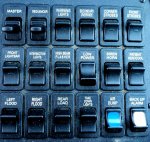Good morning,
I met yesterday someone at Camping World in Valencia and he mentioned that he has a problems with his ref.
because the Freon has to be leveled . . .
.
My ambo came with the VENNER 2-1050 CULW
http://www.vanner.com/wp-content/uploads/2010/12/EMS-Ambulance-Brochure-PDF-7-01.pdf
.
Maybe I should wait until I'll decide what to install . . .
This is probably a good idea. I don't know what my total load is going to be yet myself, and that's why I started with just one 'House Bank' consisting of 2 6VDC batteries wired in series. I knew I wanted to use 6V batteries because the battery life is longer and the amp hour rating is higher. I will install these where the old existing 12V starting batteries were in the right front corner compartment of the rear module (patient compartment). If you looked at my build thread, then you know mine is a trailer and not a full vehicle, so I have no starting batteries any longer. If I install another set of batteries, they will go in the left front compartment to balance out the weight. 6V golf cart batteries are somewhat taller and much heavier than standard light duty truck batteries. They have much larger and thicker lead plates in them, which is why they are so much heavier and why they last longer.
The ideal setup is to have two different battery systems, one for starting and one (the house batteries) for operating everything in the back when you're camping with the engine shut off. The systems should be independent of each other except when charging from the alternator. Use a charging relay such as the
Blue Sea Systems Automatic Charging Relay with Manual Control which will automatically combine the batteries or banks, during charging and isolates batteries when discharging and when starting the engine. It also allows paralleling of the battery banks for emergency starting. I, as well as the experts, do not recommend using a battery isolator. Isolators are old technology, inefficient because they do not allow for a full charge, and put a constant drain on the batteries in order to operate.
Since an ambulance is not designed to operate the electrical system with the engine shut down, it doesn't normally have deep cycle batteries. It uses normal starting or possibly the marine type hybrid batteries. The Vanner Inverter is a very good quality piece of equipment, but the charging function is only two stages, Bulk and Float. A four stage charger is better for deep cycle batteries because it has:
1. BULK STAGE
The Bulk Stage allows the batteries to be charged from the full rated output of the charger (for example, a 12V charger will charge at a maximum of 14.8V). This increased charging period reduces the overall charging time of the battery.
2. ABSORPTION STAGE
After the Bulk Stage, the charger then moves to the Absorption Stage (14.2V for a 12V battery). This mode will continue for up to 480 minutes (8 hours) to ensure that the battery receives a complete charge.
3. FLOAT STAGE
During the Float Stage, the charger reduces the charge voltage. This reduced voltage maintains the full charge while minimizing 'gassing' of the battery. The float stage prevents boiling and bulging of the battery caused when the battery is exposed to higher charging voltages for too long.
4. EQUALIZATION STAGE
If the batteries remain in a "float stage" for a seven-day period, the charger will switch into a pre-programmed Equalization Stage.
This protects the life of your battery by dissolving any sulfate layer on the battery's internal plates and avoids stratification that can occur when a battery has not been in use for extended periods.
Now that I have thoroughly confused you, it will only get better. My advice, which I learned the hard way on a couple of things, is to go slow, read and learn as much as you can about the different systems you will need, and then buy. It will save you a lot of heartache and money in the long run.


